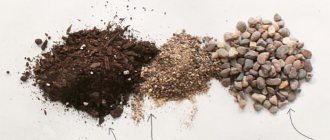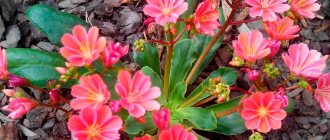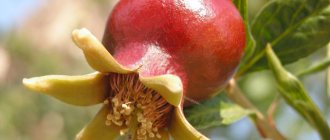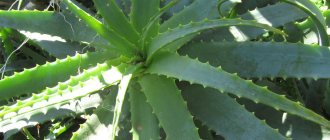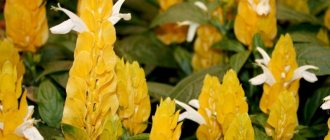Category: Succulents, Care Published 02/04/2019 · Comments: · Reading time: 16 min · Views: 3,538
Haworthia striped is a popular, although not the most spectacular succulent plant from the Asphedelaceae family. Despite their relatively modest appearance, haworthias have a lot of advantages: they can fit into any interior, adding exotic notes, look great in succulent collections, are unpretentious and undemanding. Thanks to the latter, these flowers can be grown by inexperienced gardeners and even propagated on their own. What are the features of keeping and caring for the striped haworthia and other representatives of the genus?
Homeland of the plant and structure
This flower is found in the south, southwest and southeast of Africa. In nature, the succulent prefers to settle in dry places: savannas, on the slopes of mountains and hills. In the wild it can even reach 1 m in height, while indoor varieties barely grow to 15-25 cm and even one of the “technical” characteristics is almost imperceptible growth.
Haworthia is a plant with a rosette of leaves in the above-ground part. They can be colored green, brick, and in some varieties, orange-red. And it is obvious that the main decorative effect lies precisely in the leaves. They are found in triangular, elongated, pointed and rounded shapes. The edges are decorated with frequent teeth or elongated cilia, reminiscent of fluff or cobwebs. And most varieties have pleasant-to-touch growths-tubercles of different colors along the entire length of the leaf blade.
The root system develops mainly to the sides. There, over time, individual young bushes form, which grow most actively after the death of the mother bush.
In the wild, Haworthia blooms annually, throwing out a long peduncle in the central part with inflorescences of small and rather inconspicuous flowers. Flowering indoors is not difficult to achieve, but most often it occurs only once during the entire life of the bush.
Botanical description
The homeland of the succulent from the Asphodelaceae family is hot Africa. The unusual species got its name in honor of the traveler and scientist Adrian Haworth, who studied the flora of the hot continent. The plant prefers arid areas: it can be found both under the sizzling desert sun and in the shade of bushes and trees. To withstand an aggressive climate, the crop accumulates moisture in the fleshy leaves.
Haworthia forms a basal rosette consisting of several layers of thick elongated plates. Depending on the variety, the color ranges from pearl green to a rich dark tone. Representatives of the culture can be recognized by the lumpy growths on the foliage.
The flowers of the plant are inconspicuous and therefore have no decorative value. The buds develop on long shoots (from 50 to 90 cm) and resemble a panicle in appearance. Currently, science knows more than a hundred varieties, but only a few are popular.
- Pearly (pearly). The largest representative of the genus without a stem is a huge rosette of hard, sharp leaves, the length of which reaches eight centimeters. On both sides the plates are decorated with mother-of-pearl bumps, reminiscent of precious beads. After dropping the buds, the mother bush dies, and a “daughter” grows in its place.
- Striped. The flower consists of thick leaves of a dark green hue. It got its name from the bubble lines on the surface. Externally, the variety resembles decorative aloe.
- Scaphoid. A succulent with a short “stem” and voluminous plates in the shape of a sharp egg.
- Attenuate (drawn). Not as beautiful as the above species. Small tubercles do not have a specific color. The upward-directed lanceolate leaves with sharp ends reach seven centimeters in length and one and a half centimeters in width. Develops many children and forms a dense “carpet”.
- Mix. An original tiny variety that is used in group compositions. Thick plates with a rough surface have a light green or dark green color. Rarely throws out buds.
Haworthias are credited with the properties of a protective plant. Culture protects the room from evil, irritability and fills it with positive energy. If you place a pot in the kitchen or workplace, the flower will share its vitality with the owner. Scientists have proven that the tops of this species have antiseptic and bactericidal properties.
Growing conditions
The first thing that comes to mind when you are breeding Haworthia is the simplest and most understandable care possible. It is not at all fiction that a flower can easily endure even the owner’s vacation for several weeks. The same can be said about standard care. Watering may be rare and not even regular. It is allowed not to feed the succulent (the standard elements contained in the soil will be enough for it), rarely replant it and not prune it in any way.
Temperature
Remembering the natural conditions in which wild Haworthia grows, we understand that it does not tolerate heat and direct sun.
In summer, for good growth of a succulent, about +20С is enough. And remember that this flower loves fresh air very much, so it makes sense to move it to the balcony or outside throughout the warm season.
In winter, all varieties are dormant, so it is better to keep them slightly cool. Optimal temperature background: +12-15С.
Air humidity
It is no secret that Haworthia is often recommended to all lazy or very busy flower growers. And an important role in this is played by the fact that this plant loves dry air and infrequent watering.
ON A NOTE. The humidity conditions in most rooms are best suited for Haworthia. You won't have to change anything.
In general, Haworthia quite easily tolerates both rare watering and frequent humidification of the air and soil. But if we talk specifically about proper cultivation, then it rather consists in maintaining a certain drought, a desert atmosphere around this succulent.
Lighting
Direct sunlight is strictly contraindicated for Haworthia. Again, we remember the conditions in which a flower grows in the wild. These are the slopes of mountains and large hills, but exclusively in shady places.
It is advisable to recreate the same microclimate at home. If the plant gets too much sun, it is advisable to shade it with screens or hide it behind other more light-loving plants.
What kind of pot does a flower need?
Haworthia has shallow and rather weak roots that grow strongly to the sides. Based on this, you need to select the ideal dishes for growing. It should be wide but shallow.
There must be holes in its bottom for drainage, otherwise due to stagnant moisture the flower may get sick and even die.
Choosing a place to put a flower pot
Any variety of Haworthia will do well on windowsills. But it is advisable to choose windows facing the west or east. South windows are also suitable, but then you will definitely have to shade the flower from too hot sun rays.
What does it look like in the interior?
Most varieties go very well with all modern types of interior. They are quite decorative and are even valued for the special structure of their leaves.
For example, this succulent will fit perfectly with any Scandinavian-style interior, where minimalism of shapes and lines prevails. A flower will not be out of place in a functional, high-tech hi-tech.
Caring for the plant is a pleasure. You can safely not water it for a long time, it doesn’t particularly care about additional humidification of the room, and Haworthia is not very demanding about the length of daylight hours. Therefore, as an undemanding living decoration, this succulent is a frequent choice of modern interior designers.
Difficulties in growing
Haworthia striped has good resistance to many diseases and pests. Most often, problems arise when the flower is not maintained correctly.
You may encounter the following problems when growing this indoor plant:
- The appearance of rot. Often occurs due to excessive watering. This disease affects the roots and leaves. Dark spots appear on the flower. The frequency and amount of watering should be reduced. All affected areas are removed, and the cut areas are treated with charcoal. If the root system is affected, it is better to replace the soil and remove rotten roots. It is also necessary to use chemicals (Fundazol, Oksikhomom).
- Loss of color and decorative effect. Occurs due to lack of light. The leaves of the plant begin to stretch out, the rosette becomes loose and loses its decorative effect. In this case, the flower should be moved closer to the light.
- Brown spots on leaves. Signal about the appearance of sunburn. In this case, the flower pot must be moved to another place, protected from direct sunlight.
- Cessation of development and growth. During the dormant period, the root system can “fall asleep.” Transplanting it into new soil will help to activate the flower.
- Bending of leaves at the edges, stretching of leaves, dull color of growths. This happens when in winter (rest period) the temperature is higher than permissible. It is necessary to move the succulent to a cooler room with a temperature of about +10°C.
- Drying of leaves and curling along the edges. Occurs mainly due to increased temperature and dry air in the room. A glass shelter is required to protect against too dry air and a tray for the pot with moistened pebbles.
- Changing the shape of a flower. Usually signals a lack of fertilizer or excessive growth. In this case, it is necessary to separate the daughter rosettes, replant them and apply the necessary fertilizing.
- Lethargy of leaves and their easy tearing off. This indicates that the haworthia is over-watered. It is necessary to stop moisturizing.
- Loss of color, as well as when the leaves become yellow or red. Signals an excess of fertilizers, especially nitrogen. It is necessary to reduce the application of fertilizing - no more than once every 30 days with a small nitrogen content.
- The leaves become soft and turn black. This phenomenon often occurs in strong drafts and cold. It is necessary to move the flower to a warmer room.
- Damage by insect pests (such as scale insects, aphids, spider mites, root worms). All affected parts are removed and the sections are treated with charcoal. Then insecticides are used (“Aktellik”, “Aktara”). It would be useful to replace the soil and replant the succulent.
Growing haworthia indoors will not be difficult even for novice gardeners. It is unpretentious and easy to reproduce, but it is important not to over-water it.
Features of care at different times
However, despite the fairly simple care of Haworthia, it is, of course, important to observe some seasonal features. Although they are incredibly simple and will not be an impossible task even for those who are just taking their first tentative steps in growing flowers.
in spring
After hibernation, Haworthia begins to awaken in March-April. During this period, it is necessary to increase the frequency of watering; fertilizing is allowed (it is better not to experiment and give preference to complex mineral mixtures).
In the warm season, Haworthia should be watered no more than once a week. At the same time, make sure that moisture does not stagnate in the pot or saucer underneath. It is not worth spraying the air around it until the hot summer.
Spring is the best time to transplant a plant and propagate it.
In summer
With the onset of summer, Haworthia actively grows and can even throw out flower stalks (although it does this only once in its entire life).
In summer, you can water Haworthia 1, maximum 2 times a week, if the weather is very hot and dry. It is better not to overdo it with fertilizers and apply them carefully, up to 2-3 times throughout the summer.
Recommended temperature: Warm, but not too hot. For this succulent, a light breeze blowing its leaves will be useful, and the air should warm up no more than +20-25С.
in autumn
Typically, in October-November, Haworthia's growth cycles slow down and it goes into a dormant state.
From the point of view of indoor care, you should stop all feeding of the flower, and also move it to a cool place. The ideal option is an unheated balcony or glazed veranda, where the constant temperature will remain within +12-15С without sudden changes and no higher.
The plant should be watered much less often than in summer. About 1 time per month.
ADVICE. The correct watering of Haworthia in the autumn-winter period is as follows: before moistening the soil, bring the flower 1-2 days before into a warm room, water it, then let it stand in the warmth for another 1-2 days and only then take it back to a cool place until the next watering.
in winter
In winter, Haworthia needs to be cared for in the same way as in late autumn.
Varieties and types of Haworthia with photos and names
The plant genus includes up to 150 flower varieties. And each of them, perhaps, can easily find its own characteristics and strong decorative sides.
Haworthia Striped
An easy-to-care variety with white grooves on the underside of the leaves.
Some stripes can be so wide that they visually dominate the main green coloration.
Haworthia Cooper
Quite an exotic and rare variety.
She will have to be monitored in terms of more sensitive care.
But the real reward will be the unusual leaves of the succulent, which at a certain angle resemble balls that transmit light in the upper part and seem to glow from within.
Haworthia Limifolia
Classic Haworthia with pointed leaves.
And also with a wavy pattern of tubercles along their entire length.
Haworthia Pearl
One of the most beautiful varieties in terms of decorative qualities.
Its main feature is white droplets of tubercles that resemble pearls.
This variety of succulent is also one of the tallest among all indoor succulents.
It grows up to 10-15 cm in height.
Haworthia navicularis
It is a small bush.
Densely collected boat leaves.
Haworthia Retuza
Excellent variety for growing on the window.
It is notable for its dense and large rosette bush.
And also in a variety of shades of color: from light green to purple.
Haworthia Fasciata
Almost classic in appearance, Haworthia.
It has sharp, elongated leaves decorated with white growths.
They fold into longitudinal strips.
Haworthia Mix
The variety is also called Maugani.
It has unusual leaves that are slightly blunt at the tips.
And the colors are very different: brown, purple, dark green, light gray.
Haworthia Reinwardt
The variety can grow up to 25 cm, but rarely.
This Haworthia is notable for its spirally twisted leaves.
And also good growth with a dense mat in width and height.
Haworthia Limofolia
This variety is the most light-loving.
Its main uniqueness is the always different, unique pattern of wavy tubercles throughout the leaf.
And also a light lemon shade on the upper side of the leaves.
Haworthia sinuous
This variety is often confused with aloe.
If it were not for the small white speckled balls on the contours of the leaves.
Haworthia Concolor
A variety densely covered with white tubercles.
It seems that the whole plant is covered with frost.
Haworthia Truncata
Unusual variety.
It seems as if the leaves of this succulent were deliberately cut off at the tips.
In fact, they just grow like that - with blunt tips.
The cut itself has a whitish tint.
Haworthia Alba
A variety covered with transverse stripes of white or gray.
Sometimes all the leaves are 80-90% white.
Haworthia Maugani
A variety with growing leaves that are cut off in appearance.
But only Maugani can be of very different shades.
From green to white and even brown.
Haworthia Attenuata
This is another name for Haworthia drawn.
It grows up to 7-10 cm in height and is decorated with chaotically scattered whitish droplet balls - sort of growths.
Haworthia Tortuosa
A bush with very densely growing pointed leaves.
They are fleshy and have white or gray tubercles randomly scattered along their entire length.
Haworthia drawn
An incredibly popular variety.
It is chosen for its almost complete absence of maintenance requirements and pleasant appearance with pointed leaves and small white tubercles over their entire surface.
Haworthia sticky
It is characterized by a very tight fit of the leaves to each other.
Another distinctive feature is the curly stem.
Haworthia Cymbiformis
Another name is Scaphoid.
It develops leaves that look like boats.
They are collected in a dense rosette of a bush.
If there is enough light, the leaf blade will turn several shades of green from light to dark.
Haworthia Viscose
A characteristic feature of the variety is leaves growing three in a row.
Because of this, the bush itself resembles a dense stack of folded napkins.
Haworthia Tesselata
It is also called Chess Haworthia.
Its design on the outer side of the leaf is noteworthy.
It is strewn with transversely arranged veins.
Haworthia Pumila
Very similar to the pearl variety.
But only this time the growth balls are not completely white, but seem to be transparent.
Like frozen drops of dew.
Haworthia Bayeri
Dwarf variety.
Bayeri is surprising in that it spreads like a small mat over the ground where it grows.
Haworthia Big Band
A variety of striped variety.
Just not with green, but with a lilac or reddish color of the leaf blade.
Haworthia Obtuza
A rare variety with leaves that look like water bubbles.
They are easily visible.
They also create the illusion of sea foam.
Haworthia dulled
The variety is very compact.
It produces non-pointed leaves.
They are packed together so tightly that they give the impression of neat and directed growth.
Haworthia Spider White
This is a small bush.
Which weaves around a pattern of transverse white stripes.
The stripes obviously resemble cobwebs.
Haworthia Magnifica
Succulent with dense leaves.
The leaves grow in the shape of a star.
Haworthia Nigra
A rare variety with dark green foliage.
There are also inclusions of black or brown tubercles.
Types of Haworthia
Haworthia , in Latin called Haworthia, is an ornamental succulent plant, belonging according to one classification to the Asphodelaceae , and according to another to the Liliaceae . The unusual plant is native to the rocky and sandy areas of South Africa.
The genus Haworthia includes many species and forms, which number from 60 to 600 or even more according to different classifications. All of them surprise with the variety of colors and unusual shapes of leaves and sometimes are completely different from representatives of their genus.
Every year, breeders develop several new interesting varieties of Haworthia.
Most species of Haworthia are compact succulent plants in the form of a dense multi-row rosette formed by thick, fleshy leaves. The shape of the leaves can be very diverse: in the form of an elongated pointed triangle of different sizes, scaly and even in the form of a stone.
Almost all haworthias have one common distinguishing feature - on the surface of their leaves there are warty growths, clearly or barely noticeable. For this reason, the surface of the fleshy leaves of Haworthia is always rough.
At home, haworthia blooms very rarely . Small white flowers bloom on it on a long peduncle, which is recommended to be cut off so as not to interfere with the growth of the plant.
The most popular types of haworthia grown indoors are:
Haworthia striped or Haworthia fasciata (see photo) is a succulent consisting of dark green leaves collected in a rosette, the reverse side of which is decorated with white warty stripes.
Pearly haworthia , in Latin called Haworthia margaritifera (see photo) is the largest haworthia in the form of a rosette of green leaves covered with pearlescent white nodules with small spines along the edges.
Cobweb-shaped Haworthia or in Latin Haworthia arachnoidea (see photo) is a compact succulent in the form of a rosette assembled from triangular leaves. They are bordered by long thin cilia, which, like cobwebs, entwine the plant.
Haworthia mosaic or checkerboard, in Latin called Hawortia tesselata (see photo) is a plant in the form of a compact rosette of dark green pointed leaves decorated with a light green mosaic pattern.
Haworthia limofolia or in Latin Haworthia limifolia (see photo) is a small plant of rosettes, the leaves of which are dotted with longitudinal warty stripes on the reverse side.
How Haworthia blooms
As a rule, flowering time occurs at the end of spring or the first days of summer.
The flowering of Haworthia itself is very inconspicuous and fleeting. The plant throws out one long peduncle, on which small, most often white flowers appear. Haworthia can grow from 5 to 20 years, even indoors, but it can bloom only once.
But in any case, the main decorative feature of Haworthia is always its beautiful and extraordinary leaves. Most gardeners grow the flower precisely because of the unusual appearance of the bush, and in order not to waste the plant’s energy on frankly inconspicuous flowering, they cut off the peduncle as soon as it begins to appear.
Transplanting a plant step by step
The plant should not be replanted often, as it grows slowly. In the Haworthia standard, the pot is changed every 2-3 years or even less often.
- Carefully remove the flower from the old pot so as not to damage the weak surface roots.
- Clean the root from the soil and, if desired, treat it with a weak solution of fungicide.
- In a new container, cover the drainage area to about 1/3 of the volume.
- Plant the bush and cover it with soil without compacting it.
- Place the plant for 10-15 days in a bright place and shade it from direct sun.
A signal that this succulent already needs replanting is usually the drying tips of the leaves.
Pests
A few enemies of Haworthia:
Shield. The solution is treatment with insecticides “Aktellik”, “Aktara”.
Root mealybug. Solution - you need to remove the plant, rinse its roots with warm water and immerse it in the Aktara or Mospilan solution for 5 minutes. After treatment, the plant should be dried for 24 hours and planted in fresh soil in a new pot.
After two weeks, you need to repeat the treatment by treating the soil with an insecticide solution.
How to plant a flower
Haworthia grows in width, and this quality is most often used in its propagation. The old bush remains in the center, and the young ones grow next to it. They can be carefully separated from the mother bush during the next transplant.
The root system is trimmed with a sharp knife and the new shoot is transplanted separately.
It is recommended, however, not to immediately move a sprout with a damaged root into the ground, but to keep it for up to 7 days, without planting it anywhere, to heal the wounds, and only then replant it in a permanent place.
Reproduction in different ways
Haworthia lends itself to all the most common methods of reproduction.
Propagation by cuttings
During the next transshipment, you can divide the root system and the bush itself into several parts and transplant them into different pots.
By the way, many advise not to immediately replant damaged parts of plants, but to let them dry in the air for several days so that they do not develop root rot.
Leaf propagation
The leaves are separated from the mother plant and placed in a separate container in sandy soil. There is no need to dig them in. It is also not worth maintaining high humidity.
Usually after 2-3 weeks the leaf takes root (you can spray it with Kornevin). Over time, a rosette of a new bush appears nearby, and the mother leaf bush gradually dies off.
How to reproduce by children
A very simple option. During the next transplantation, young growth calves from the main bush (in adult plants, it itself grows along the edges of the main plant). Its root is unraveled and a new bush is planted separately.
How to root a flower
Haworthia easily takes root in sandy-peaty soil and without high humidity. But you can simplify the reproduction process by adding the drug “Kornevin”.
How to plant without roots in a pot
Even leaves of Haworthia take root easily, let alone whole cuttings, etc. If you need to replant a plant without a root, then you can simply place a separate healthy leaf on light soil and not even dig it in.
Over time, it will give a root, and then a new plant will emerge from it. The old part of the leaf will simply die off.
Reproduction
The most suitable time for reproduction is spring. The main methods of propagation of Haworthia are propagation by lateral shoots and leaf cuttings.
Haworthia often has daughter rosettes that can be easily cut off with a knife . If such a shoot has its own roots, it is immediately planted in a separate pot. If there are no roots, the “baby” is dried for 3-4 days, and then sits in the sand for rooting. This method of reproduction is the easiest and fastest.
When propagating Haworthia by leaf, the leaf is carefully broken off from the mother plant. Then the cuttings are dried for 2-4 days and planted in sand.
Do not water the cuttings for 3-4 weeks after planting , but only lightly sprinkle the soil until roots appear. To avoid rotting, do not cover the container.
Watering at home
Water your Haworthia so that the soil is not wet for a long time. It is recommended to wait until it dries to a third of its depth. Remember, succulents are more prone to drought than excessive humidity.
- In summer, water the plant no more than 1-2 times a week.
- In autumn and winter - 1-2 times a month.
Completely empty the saucer under the pot 10-20 minutes after watering. It is not particularly recommended to spray Haworthia. But even if there is a desire to increase the air humidity in the room (for example, due to neighboring plants), be sure to remove any drops from the leaves of Haworthia.
Reproduction of Haworthia striped
The best time to propagate such a plant is spring. The methods that can be used are the following:
- Children . During the transplantation process, the roots of the children are planted in separate pots. The root rosette is planted in a moist substrate.
- Seeds . Propagating Haworthia in this way is not so easy, since it will take a lot of time. This method will appeal to breeders.
- Leaves . They are cut off from the bush, and after they lie down for a while, they are placed in loose soil moistened with water, or in a sandy substrate. The plant is not watered for 1 month and during this time it begins to take root.
You can learn more about the nuances of haworthia propagation here.
Watch a video about the propagation of striped Haworthia:
Diseases and pests
Haworthia is slightly susceptible to diseases and pests. But even this unpretentious flower has problems. First of all, most of them are associated with excess humidity in the air or soil in the pot.
- The most dangerous disease is fusarium or root rot. Weak roots are susceptible to it due to high soil moisture. With severe development of the disease, the leaves at the base turn black and easily tear off. The only thing that will help is replanting it in a new breathable soil and removing all the roots damaged by root rot.
- Among insects, scale insects often settle on Haworthia. And this is due to the fact that the plant becomes infected due to its proximity to diseased flowers. Scale insects are dangerous in the sense that, feeding on the sap of the plant, they dry out its leaves.
- Sometimes root worms appear in the soil. You can understand that the pest has long been attracted to Haworthia by the whitish coating on the leaves of the flower and white flakes on the surface of the soil - this is the waste of the insect.
Haworthia is usually not difficult to treat. They are saved from diseases by transplanting the healthiest parts of the bush. And they get rid of pests using standard treatments with folk remedies or purchased medications.
Why do Haworthia leaves dry out?
Leaves are the main decorative element of Haworthia. If they do not look their best, then all the beauty of this flower is lost.
Leaves can dry out:
- Due to the presence of scale insects or root scale insects;
- Due to the proliferation of spider mites (dry air);
- The tips dry out when there is not enough heat or the flower is blown by too cold a wind;
- If the flower receives a lot of direct sunlight;
- Leaves may also turn yellow or red due to an excess of fertilizers.
Description of the plant
The homeland of Haworthia is South Africa.
Now about 100 varieties of the plant are known. All of them are highly decorative and original in appearance. Many types of succulent have fleshy, dense leaves that form rosettes on the surface of the ground, and some have a short stem.
The peculiarity of Haworthia is the accumulation of moisture in the leaves. In nature, this property helps the plant survive periods of drought.
Some types of haworthia have white bulges on the surface of the leaf blades, which give the succulent a decorative appearance. Haworthia flowers are small.
More often than others you can find the following varieties:
- striped;
- pearl;
- Haworthia Reinwardt.
The most common species in floriculture is the striped Haworthia. It is a stemless plant with dark green leaves with small white tubercles. Merging, they form original stripes. An adult plant can reach up to 0.2 m in diameter.
Haworthia is not poisonous. In folk medicine, the plant is used as an antiseptic. A sheet cut in half can be applied to the wound for faster healing and disinfection.
How to resuscitate?
Rescue measures are quite simple.
Relocating to a more favorable place (for example, where it is not damp and warm) helps with illnesses. Timely treatment will help against pests - just don’t get carried away, but act strictly according to the instructions.
Otherwise, remember the main rules: Haworthia does not need direct sunlight, it does not like humidity and loves coolness, not extreme heat. Accordingly, choose such a place for her, and you will not have to face most common problems.
Common mistakes
Despite the ease of growing Haworthia, there are the most common mistakes in caring for it.
- With a minimum of light, the leaves of the flower become limp, drooping and are easily damaged even from touching.
- If the plant gets a lot of direct sun, the leaves on it darken and curl. Shade the place.
- This flower can be easily filled. If there is excessive moisture, the leaves become watery, and in the worst case, they rot and turn black at the base.
Avoid these mistakes to ensure your Haworthia always remains beautiful and fragrant.
Answers to popular questions
Why is my Haworthia growing slowly?
Don't rush to sound the alarm. Extremely slow growth is a feature of this plant.
Leaves often turn yellow and fall off.
Most likely, the reason lies in the too bright sun hitting the plant.
The leaves do not look dry and hard, but soft and drooping. Why?
It is very likely that you are pouring Haworthia. This flower, on the contrary, loves drought, and generally needs to be watered no more than once a week in the summer. And in winter - once a month.
